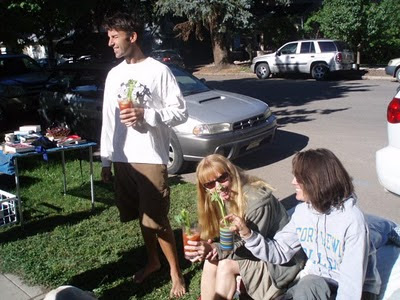 I was at a meet-and-greet last night with Brian O'Donnell, who's running for State Representative for District 59, and he and I got to talking about things I was feeling about Obama (what is it with his inability to articulate clear rationales and guiding visions?), the Democratic Party (how can they continue to be so staggeringly fumbling, bumbling, and timid since the Carter Administration?), the Tea Party (who are fighting tirelessly for our RIGHT to get dicked by insurance companies, to have our jobs outsourced overseas, to a crappy education and low-paying unskilled jobs!), and -- of course! -- to the economy (when will someone have the backbone to say that Free Trade has been the biggest shafting of the middle-class worker since Indentured Servitude?).
I was at a meet-and-greet last night with Brian O'Donnell, who's running for State Representative for District 59, and he and I got to talking about things I was feeling about Obama (what is it with his inability to articulate clear rationales and guiding visions?), the Democratic Party (how can they continue to be so staggeringly fumbling, bumbling, and timid since the Carter Administration?), the Tea Party (who are fighting tirelessly for our RIGHT to get dicked by insurance companies, to have our jobs outsourced overseas, to a crappy education and low-paying unskilled jobs!), and -- of course! -- to the economy (when will someone have the backbone to say that Free Trade has been the biggest shafting of the middle-class worker since Indentured Servitude?).Well, I enjoyed the meeting, even if it might have been a bit heavy on the "greet" for poor Mr. O'Donnell. But he listened (or feigned listening) as politely as a ... well, a politician. Which he's not. Yet. (Despite J. Paul Brown's supporters are mailing literature accusing O'Donnell of being a "tax and spend politician," even though he's never held office. He has, in fact, been working as a wildlands advocate for Trout Unlimited.)
O'Donnell and I did end up find some shared ground, though: Our respect for economist Robert Reich.
Last night Reich reminded me why that's so, when he was interviewed on NPR's "Fresh Air." In the 20-minute interview, Reich is refreshingly clear, logical, and honest as he explained his view of where we are economically, and how we got here. And where we are is where we were at the start of the Great Depression: with a historic concentration of wealth in the hands of the wealthiest few, and a crushed middle class unable to afford to keep fueling the economy.
In 1928, says Reich, 23 percent of the country's wealth was in the hands of the richest 1 percent of the population; in 2007, the had 23.5 percent. Census data released this week show that the top-earning 20 percent of Americans received nearly half the income generated in the United States.
Reich cites some clear steps in how we got here, including the mechanization then out-sourcing of the workforce, an overly indebted middle class, and an absurdly wealthy upper class that turns to speculation as sport.
And he shares the concern over President Obama's lack of skill in articulating the situation and a rationale for moving beyond it, playing into the hands of Tea Partiers and those who would keep the status quo. "He [Obama] has failed to connect the dots," says Reich, "and failed to provide the public a large and understandable narrative."
Like Reich can.
Listen to or read the "Fresh Air" interview here.
Watch an interview with Reich about his new book Aftershock: The Next Economy and America’s Future here and below.








